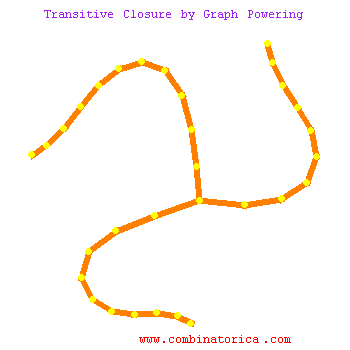Transitive Closure by Graph Powering
This animation finds the transitive closure of a graph by taking its adjacency matrix and raising it to the nth power, where n is the number of vertices in G. When we raise the graph to the kth power, we add exactly the edges which represent paths of length k in the original graph.
In this animation, red denotes most recently added edges, blue the edges added the previous iteration, and green the edges two iterations before, before the edges cool to black. The original graph edges are shown in orange. A computationally cheaper way to find transitive closure is to use Warshall's algorithm, but graph powering also allows us to count how many paths there are of different lengths.

graphpower.gif - The Animation.
graphpower.nb - Notebook file.
These animations were produced using Combinatorica -- see www.combinatorica.com and our book Computational Discrete Mathematics: Combinatorics and Graph Theory with Mathematica for more information.
Check out our dfs/bfs, connected components, Hamiltonian cycle, Eulerian cycle, shortest path, transitive closure, and minimum spanning tree animations!